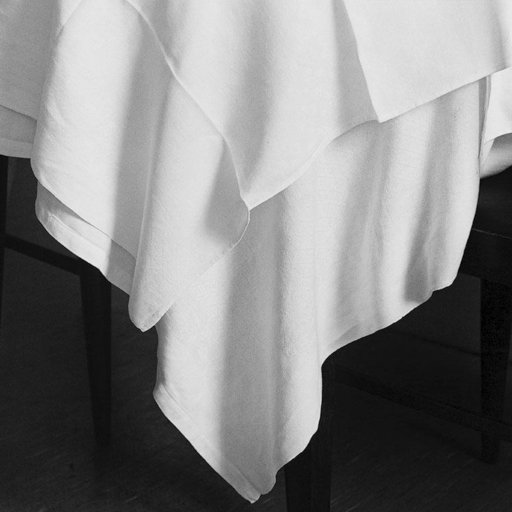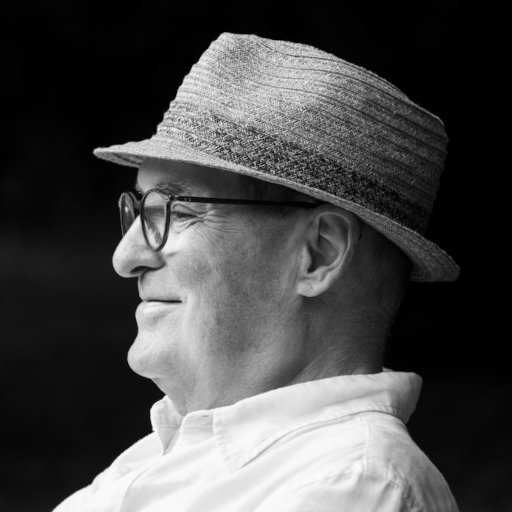
From the State of Things to a Sense of Place (Cristina Zelich)
Ferran Freixa began working as a photographer and graphic designer at an early age, and opened his first studio in Barcelona in 1960. Several years went by before he appeared in his first group show, at the Da Barra gallery, in 1973. The 1970s, and particularly the latter part of the decade, brought a veritable revolution to what was known as creative photography. A new generation of photographers emerged which, according to Pere Formiguera, “had blind faith in photography as a vehicle for artistic expression, no different from the other visual disciplines being pursued at the time. It only made sense that photography should be given equal treatment and the same opportunities for exposure as those granted to other disciplines.”
In Barcelona, the photographers from that generation met and developed close friendships, first through the Spectrum gallery, which opened in Barcelona in October, 1973, and later around the Fotomania and Procés galleries, inaugurated in October 1977 and May 1978 respectively. These galleries introduced the prevailing trends in creative photography from Europe and the United States: on the one hand, “fantastic photography” with artists such as Jerry Uelsman and Paul de Nooijer, dreamlike images such as those by Arthur Tress, and staged photography, featuring artists such as Les Krims and Duane Michals; on the other hand, documentary photography seen through the eye of the artist, openly subjective, focusing on everyday life or personal experience, with names such as Bernard Plossu, Claude Nori or, with a far less poetic, harsher treatment, Manfred Willmann.
In this context, the work of Ferran Freixa—which has been placed in the category referred to as “formalist and subjective documentary”—began to acquire some of the defining features that would constitute the foundations of all his later production. Clearly, his commercial work as a graphic designer and architectural photographer marked his path in photography from the very start, not only from a purely formal perspective, but also in terms of its content. Frontality, the balance in his compositions, the use of highly precise, controlled framing, and the understanding of the importance of light—the raw material of photography—in the construction of an image are some of the elements that define the work of Ferran Freixa.
In one of his first photographs, taken on a tip to Holland in 1976. Freixa shoots the local architecture reducing it to purely graphic elements, stripping it of all references to scale, favoring the interplay of lines and shapes, and presenting architecture as isolated from its surroundings, devoid of volume, cut out against a flat, textureless sky. This quest to reduce architectural forms to simple lines and flat expanses is also present in the series of images captured that same year in Menorca, although here the compositions are more dynamic and the geometry of the lines is interrupted by the subtle appearance of plant forms.
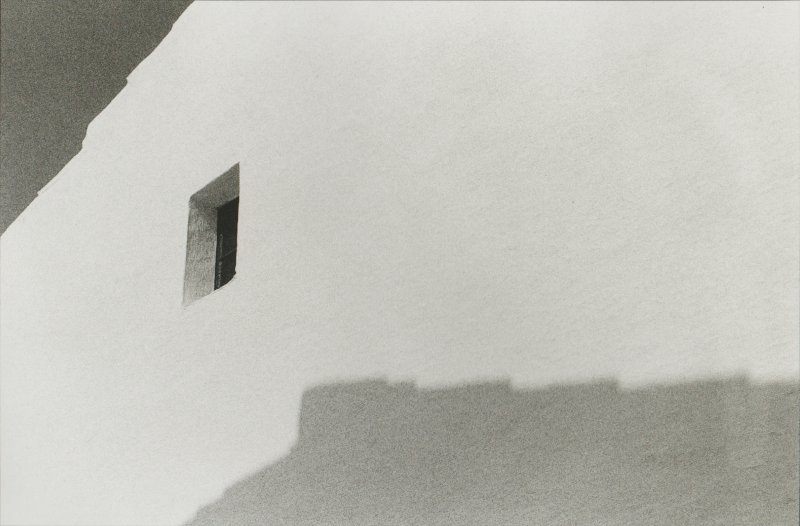
In the Menorca series we also begin to see another element whose presence gradually increases Over the course of Freixa’s development: the observation of the passage of time embodied in ruins, abandonment, the slow but steady advance of nature, reclaiming ground once lost to human constructions; stone eroding from exposure to the elements, empty old palaces bearing witness to ways of life long gone. It is the same perspective we find years later in the photographs taken in Florence (1984), in the Tarraco series (1997) and in the images shot in Rome (2003) and Sicily (2004).
One of the more recent series, begun in 2006, deserves separate attention. Its photographs focus on abandoned industrial architecture, buildings that years ago ceased to be useful, closed down, and slowly and silently fell into oblivion, particularly those from the old textile communities built from the last third of the 19th century on around the mills powered by Catalan rivers as an alternative to coal, and which continued to operate until the 1960s. With these communities, a new river landscape developed, with a new kind of riverside settlement. The awareness of the need to preserve this industrial heritage, the symbol and remembrance of times past, and the acknowledgment of its cultural value, have determined interpretation policies that have tended towards museumization. As Esperanza Marrodén notes, “This need to provide a didactic explanation of a model of labor organization, or to preserve the memory of a group of long-lost workers, ends up turning architectural remains to fictional representations of the past” 1. Freixa documents industrial ruins before they are subjected to restoration, and, again, through his gaze, offers us a reflection about the passage of time, about the demise of human enterprises, about the fate of these obsolete production buildings which in their heyday were erected as symbols of industrial progress and now, buried in silence, grown over by vegetation, offer themselves as subjects for aesthetic appreciation.
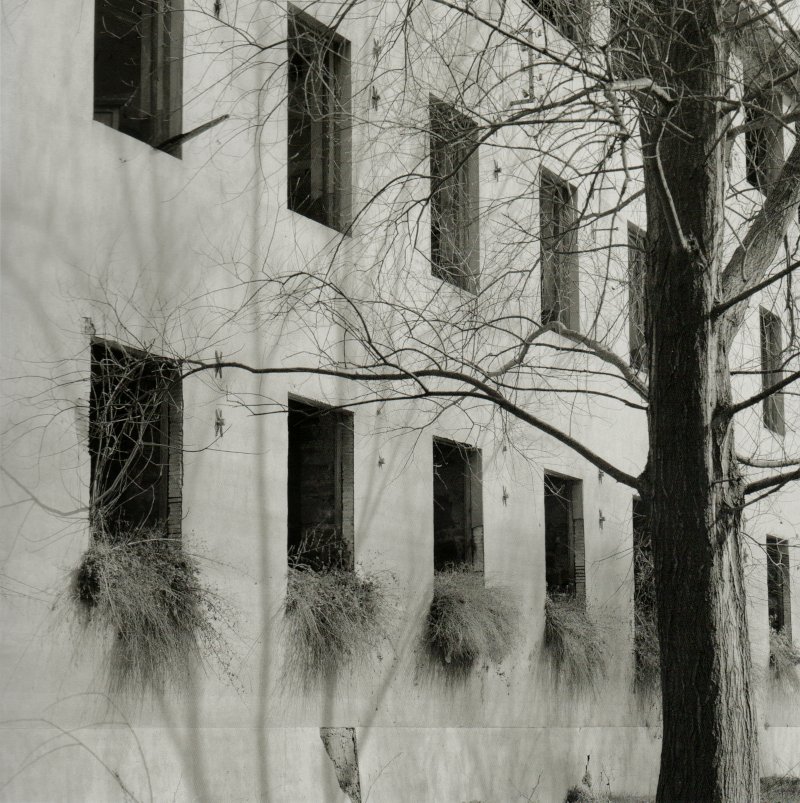
In the late 1970s, the city was one of the recurring themes in European photography. In the case of Ferran Freixa, his interest in the urban environment is inextricably bound to his experiences in that setting. It is the context in which he completed one of his best-known series: his photographs of shopwindows. Freixa’s aim is not to catalogue or inventory these spaces that are doomed to disappear. “Many times, when I take pictures of these shops, I remember my childhood; very dear memories come back to me,” says the artist. “That’s why I take them. I’m afraid of their being lost and I want to leave some kind of record.” 2 And truly, the shopwindows (1979), but also the interiors of shops that he captures, appear to have been frozen in time, each at a specific moment in the early 20th century, the art deco period, or the 1950s. In the realm of photography, these images immediately bring to mind a surrealist object, on the one hand, and, on the other, a standardization of elements reminiscent of industrial production, typical of the New Vision photography of the 1920s. The fascination that objects hold for the artist is undeniable. However, and although it is true that they lend themselves to a variety of interpretations, I would like to point out the sense of eeriness—the Freudian notion of Unheimlichkeit—that emanates from this ensemble of pieces, and which we come across again in one of Freixa’s most recent works from 2013, the photographs taken at the historic Bar Marsella in the Raval neighborhood in Barcelona, whose existence is now seriously endangered. We are overcome by this sense of eeriness when something familiar begins to change and is presented to us as different from its original meaning. Temporal uncertainty is the result of encountering a state of things in flux that has a direct impact on our perception of those surroundings which had been familiar to us up until then. In this respect, it is interesting to consider Jonathan D. Snyder’s approach in referring to the photographs of shopwindows and deserted interiors (Hotel Maria Cristina, the Gran Teatre del Liceu opera house before the fire, the Teatro Victoria Eugenia), according to which “the uncanny aesthetics of Freixa’s works gesture towards erosion of identification with places that at one time seemed more familiar. The trace then, like these material objects, becomes endowed with the force of an anachronous remainder that survives the passage of time.” 3
Over the years following the shopwindow series, Freixa produced a magnificent body of work whose main subject was restaurant tables, with their pristine white ironed tablecloths, their neatly placed dishware, their stacks of plates and napkins. While in the former series the objects appeared to be waiting for something to happen—a pair of hands to put on a pair of gloves, a body to sit down in the barber’s chair—here the presence of empty seats, upside-down wine glasses, or an artistically folded napkin, prelude an event. However, there is something in the image—the stiffness of the starched folds, the meticulous placement of the table service—that thwarts the possibility of any action, condemning all the elements to an endless wait. We may suspect that on the photographer’s part there is a desire to preserve not so much the memory of a series of places as a state of things, a harmony, a stillness, a symmetry.
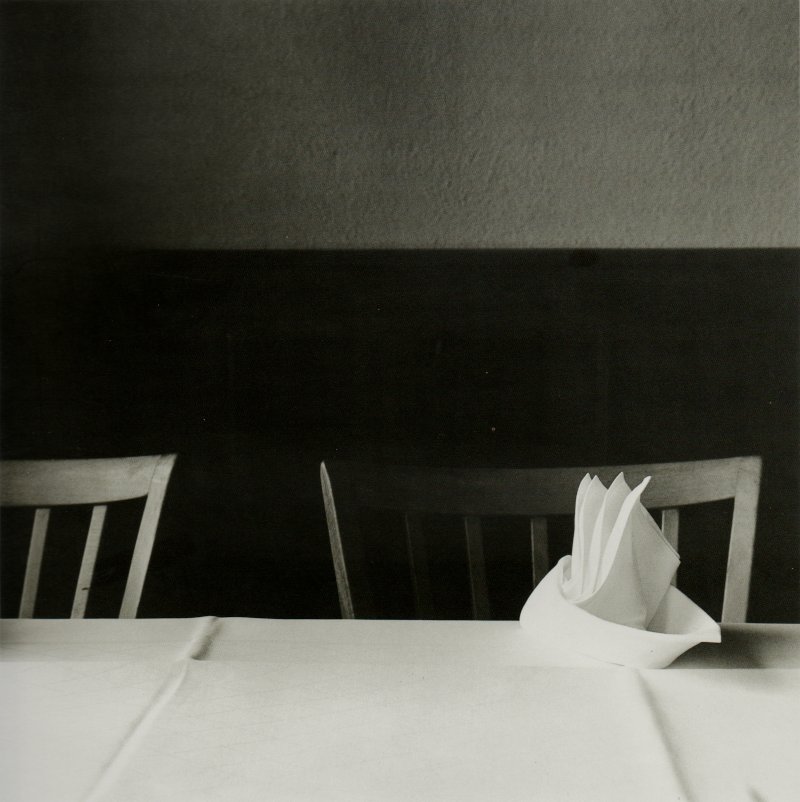
Years later, in 2008, Freixa traveled to Beijing. Upon his arrival, he realized that new buildings had replaced almost all the traditional architecture in the ancient imperial city. The urban landscape was entirely different from what he had set his mind on capturing, and he experienced a “sense of divorce” 4 from the landscape of reference he had in mind, which led him to seek out and photograph the unexpected reality of those elements that enabled him to establish a link with his iconic world. That is why the only image from the trip to Beijing included in the exhibition is a table at a restaurant with the ephemeral sculpture of a folded napkin set against a dark background.
Earlier on, I mentioned light, the raw material of a photographer’s work. That strong, oblique southern light that intensifies lines, enhances textures, draws architectures, and gives depth to walls, creating shadows and contrasts. Or the light that succeeds in transforming a street, a corner of the urban landscape, into a stage set with cinematic resonances in which a human figure hurries by.
Light is also what appears to chisel out the stone surface of a quarry. In contemporary photography, we find numerous examples of what Alain Roger refers to as “artialization,” 5 which is the process of attributing aesthetic quality to everyday objects. Any landscape necessarily implies a process of artialization. The deep wounds carved out in the earth by industrial use, mining, or stone quarrying, as well as for building the roadways that are inextricable from urban sprawl, become landscapes in the photographer’s eye. We recall the landscapes proposed in the New Topographics 6 exhibition in the United States, and, in Europe, for example, the output of the photographers who worked in France on commission from DATAR. 7 Ferran Freixa has pointed his lens at the sandstone quarries in Menorca (2002) and the marble deposits in Almeria (2006), using his framing and the interplay of light and shadow to create monumental landscapes that transfigure the reality of the locations that have been definitively altered by the hand of man, and endowing them with aesthetic values of which they had been devoid until then.
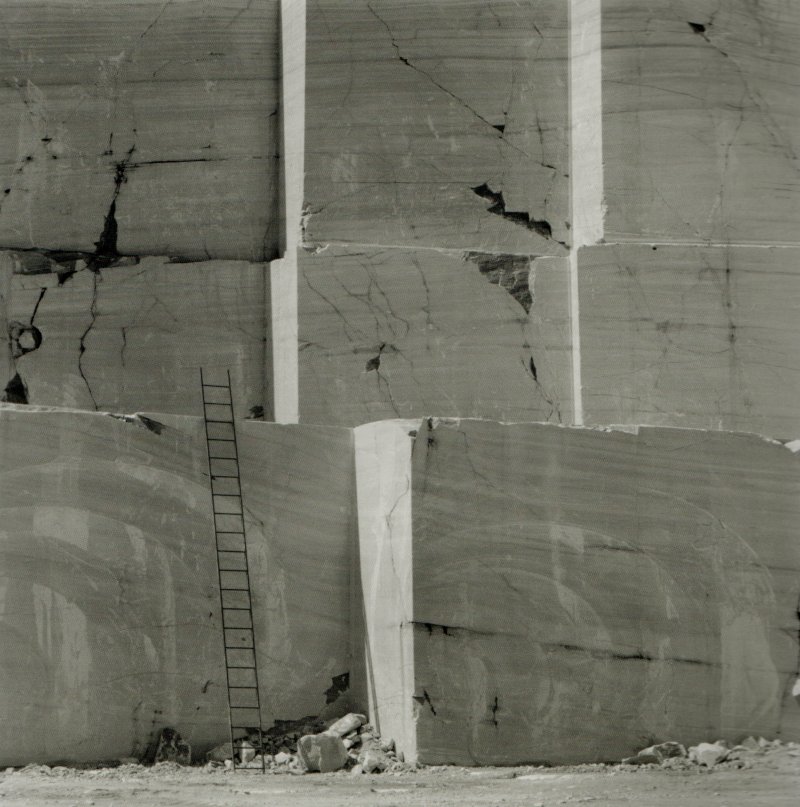
To end this itinerary through the different facets of Freixa’s work, there is an area of experimentation within his output that we must not overlook. One example is a series produced in 1987 for the Museu Nacional Arqueològic in Tarragona, in which the photographer chose to synthesize form and content in each image, shooting what appeared on the museum’s walls when he projected photographs of certain pieces from the collection, sculptures that dematerialized to become luminous shapes. He would later use a similar approach in the photo series produced for the Casa de las Ciencias in A Coruña in 1989.
Among these experimental works, we must also include the series about the port of Barcelona (1989) in which he used a wrinkled sheet of plastic, placed between the lens and the object he was photographing, to suggest the rise and fall of the waves; or the images in the Gimlet-Cocktails series (1992), staged by the author with a minute human figure strolling between shiny martelé metal cocktail mixers that become an evocative urban film noir set.
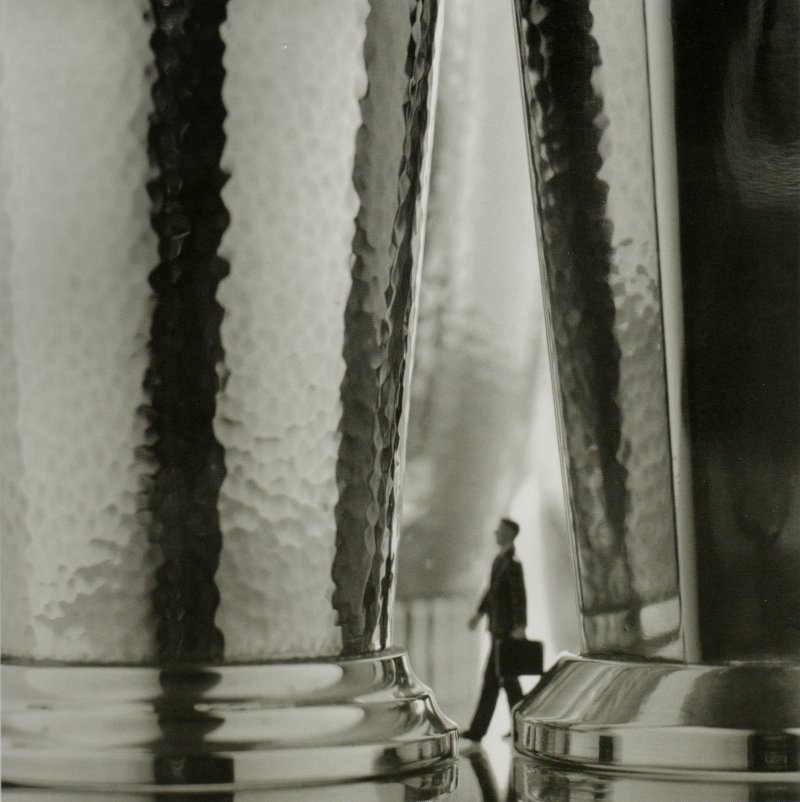
In 1990, Freixa completed the L’Eixample series, documenting his comings and goings through the Eixample neighborhood in Barcelona to and from his studio, which at the time was located on Carrer Provenca, a few steps from Gaudi’s La Pedrera. They are strange images that break away from the balanced compositions of his previous and subsequent work. The photographs are taken from below, with the lens pointed up to the sky, as if the photographer, with the camera placed in his lap, wandering through the city in a bus or a car, had released the shutter at different random points along his itinerary. In all of them, the outline of the vehicle appears in the foreground as a blurry shadow superimposed on glimpses of the city. The images are caught surreptitiously, with the photographer doing nothing more than pressing the shutter release.
Earlier on I mentioned the role of ruins in Freixa’s work as a metaphor for the passage of time, but the intention behind the images of the Gran Teatre del Liceu opera house after the 1994 fire is entirely different. The Liceu was not only an iconic landmark in Barcelona for Ferran; as an opera lover, he also felt it to be an important part of his emotional background. It was not easy to gain access to the burnt-down theater, but Freixa did not cease in his efforts until he was given permission. His idea was to document the charred remains as if they were an archeological dig. He did not hesitate to use a plate camera, spot lighting, and color film to achieve his aim. “Every day that passed, things that I wanted to record were lost,” claimed the artist in an interview with Nuria Gras in 2010. “Sometimes I barely had time to shoot the picture before the workmen cleared the area. I worked away in the theater for hours on end, because I knew that the next day, the image I had just discovered would no longer exist.”
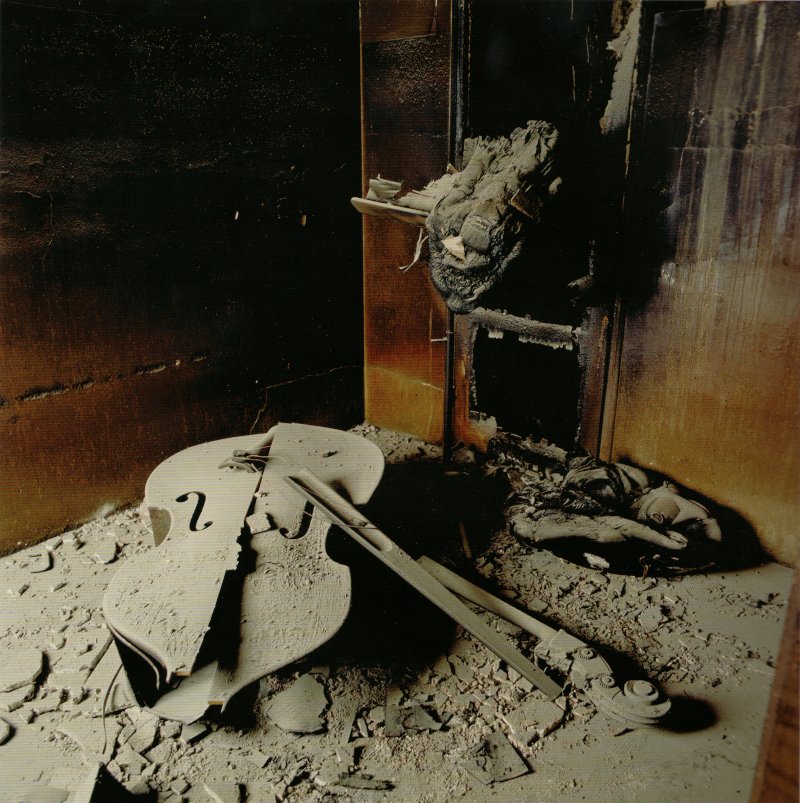
Yes. To capture that which is fleeting, changing, evanescent; to maintain balance and harmony, use photography to construct a sense of place, like in that image of an unusually calm Cantabrian Sea in the late afternoon, receding to draw the profile of a woman’s head on the sand 8: that is the essence of Ferran Freixa’s work.
1 – Marrodán, Esperanza, «De la fascinación formal a la nostalgia. La ruina industrial en el paisaje contemporáneo».
2 – Artigas, Teresa, «Escaparates de Barcelona», in El Correo Catalán, september 21st 1979, pp. 18-19. Picked up in Fontcuberta, Joan, Historias de la fotografía española. Escritos 1977-2004. Barcelona: Gustavo Gili, 2008, p. 84.
3 – Snyder, Jonathan D., «Reading Culture at the Treshold: Time and Transition in Modern Spain (1800-1990)». Michigan: University of Michigan, 2008, p. 197.
4 – Nogué, Joan, «El retorno al paisaje», in Enrahonar, issue 45, 2010, p. 130. Nogué examines the growing sense of divorce between the landscapes we imagine and the ones we experience. The landscapes we imagine are the landscapes of reference that are passed down from one generation to the next through vehicles as varied as landscape painting, photography, textbooks, or the media.
5 – Roger, Alain, Breve tratado del paisaje. Madrid: Biblioteca Nueva, 2007.
6 – «New Topographics: Photographs of a Man-Altered Landscape», an exhibition organized by William Jenkins and held at the George Eastman House International Museum of Photography, in Rochester, New York, January 1975.
7 – «Mission photographique de la DATAR», a public venture in which 28 participating photographers were commissioned to portray the French landscape of the 1980s.
Individual Exhibitions
1976:
- La PhotoGalería, Madrid.
1977:
- Spectrum-Canon Gallery, Barcelona.
- Galeria Il Diaframma-Canon, Milano (Italy).
1978:
- Atelier-Galerie de Photographie, Ais de Provença (France).
1979:
- Demi-Teinte Gallery, Paris (France).
- Fotomanía Gallery, Barcelona.
1980:
- Spectrum-Canon Gallery, Girona.
1982:
- El Setze Gallery, Martorell.
1983:
- Berner Photo-Galerie, Bern (Switzerland).
- Agathe Gaillard Gallery, Paris (France).
- Forum Gallery, Tarragona.
- Spectrum Gallery, Zaragoza.
1985:
- Image Club, Barcelona.
1986:
- Contraluz, Barcelona.
- Dos Peiraos Showroom, Vigo.
1991:
- Provincial Museum of Huelva, VII Month of Iberoamerican Photography, Huelva.
1992:
- Gimlet Bar, serial Gimlet-Cocktails, Barcelona.
1993:
- Textile and Clothing Museum, TextilCafe, Barcelona.
1994:
- University of Salamanca, “Ferran Freixa 1977-1994”, Salamanca.
1995:
- Historic Territory Archive of Alava, Vitoria-Gasteiz.
- Fine Arts Circle, III International Biannual, Photonovember, Santa Cruz de Tenerife.
1996:
- Showroom of Canal de Isabel II, «Ferran Freixa 1977-1994», Madrid.
- Virreina Palace, «Gran Teatre del Liceu. Fire, last act», Primavera Fotografica 1996, Barcelona.
1997:
- Railowsky Photogallery, «Ferran Freixa, 1977-1994», Valencia.
1998:
- Centro de Cultura Antiguo Instituto / Ateneo Obrero de Gijón, «Ferran Freixa 1977-1994», Gijon.
2000:
- Galerie du Chateau d’Eau, Toulouse (France).
2002:
- La PhotoGaleria, presentation of the book Ferran Freixa, Col. PHotoBolsillo, n. 40, Madrid.
2005:
- Robert Palace, «La vitrina del fotograf», Barcelona.
2012:
- Centre Experimental de les Arts, Photographic Space Humberto Rivas, «Complicitats», Vallgrassa, Parc del Garraf, Barcelona.
2013:
- Tagomago Gallery, «HARMONIES, photographies et tirages d’époque», Paris (France).
- Art Center Tecla Sala, «Ferran Freixa. Photography 1973-2013», Hospitalet de Llobregat.
2016:
- PhotoMed, «Comme le temps passe». Mediterranean Photography Festival. Sanary-sur-mer (France).
2018:
- Revela’t, “Odysseys”. Analogic Photography Festival. Silver Pin. Vilassar de Dalt, Barcelona.
2022:
- Boca del Calvari Museum, “Ferran Freixa. La luz presente”. Benidorm (Alicante).
2023:
- MetroQuality, “L’atessa dell’attimo”. Salone Internazionale del Mobile, Milano Design Week, Milano (Italy).
Collective Exhibitions (selection)
1973:
- Da Barra Gallery, «La bella i la béstia», Barcelona.
1977:
- Chez Rouve/Vinci 1840, «Photographie d’architecture», Paris (France).
- La PhotoGaleria, «9 catalan photographers», Madrid.
1978:
- Cultural Center Juana Mordó, Madrid.
- Musée d’Art et d’Histoire de Fribourg, II International Triannual of Photography, Fribourg (Switzerland).
1979:
- Spain Art Gallery, «Spanish Photography», New York (USA).
- Lleonart Gallery, «Homenatge a Man Ray», Barcelona.
1981:
- Night Gallery, «Spanish Photography», London (United Kingdom).
- Center for Creative Photography, «Contemporary spanish photography», Santa Fe (USA).
- Canon Photo Gallery, Geneve (Switzerland).
1982:
- Galeries FNAC, «8 photographes en Catalogne», Paris (France).
- Castello Svevo, «Fotografi spagnoli contemporanei», Termoli (Italy).
- Camera Obscura Gallery, Stockholm (Sweden).
1983:
- Nikon Gallery, Zurich (Switzerland).
- «Place and Identity in the European Photography», itinerant at Rimini and Pordenone (Italy).
- «L’architecture: sujet, objet ou prétexte?», itinerant at Agen, Baiona and Bordeux (France).
- Fine Arts Circle, «259 Images. Actual photography in Spain», Madrid.
1984:
- Ciento Gallery, Barcelona.
- Cultural Center of Caixa de Pensions. «Mediterranean photography». Barcelona.
- Joan Miró Foundation. «La ruina». Barcelona
1985:
- Montcada Showroom, Caixa de Pensions Foundation, «Nights», Barcelona.
- Galerie Arpa/Entrepôt Laine. «Natures mortes», Bordeux (France).
1986:
- New Mexico University. Contemporary Spanish Photography. Albuquerque (USA).
- Spanish Museum of Contemporary Art. «Photography in the museum», Madrid.
- Douarnenez’86, 9th Cinema Festival of the National Minories, Douarnenez (France).
1987:
- National Arqueology Museum of Tarragona, «Tarraco: object and image», Tarragona.
- Showroom of Canal de Isabel II, «Escenarios de la guerra». Madrid.
- Center for Creative Photography, Arizona University, «Contemporary Spanish Photography», Tucson (USA).
1989:
- Arcs Showroom, Caixa de Barcelona, «Water door. Ten visions of the Barcelona Port», Barcelona.
1991:
- Biannual Photography Table, «Contemporary catalan photographers», Xarxa Cultural Collection, Universitary Club, Tortosa.
- National Museum Art Center Reina Sofia, «Four directions: contemporary spanish photography 1970-1990». Madrid.
1992:
- Virreina Palace, «Musa Museu, fotografs contemporanis als museus de Barcelona», Primavera Fotografica 1992. Barcelona.
- Art Museum of Girona, «Objective: MD’A The museum seen by 7 photographers», Girona.
- Laie Bookstore, «Textual Images. Columbus and Barcelona», Barcelona.
1992/1993:
- Itinerant exhibition at Spain and other countries of Europe, «Four directions: contemporary spanish photography, 1970-1990».
1993:
- IVAM, Julio González Center, «Gabriel Cualladó Collection», Valencia.
1994:
- The Special Photographers Company, «Spanish Photography», London (United Kingdom).
- Photographers Gallery, «Four directions: contemporary spanish photography, 1970-1990», London (United Kingdom).
- Architects College of Catalonia, «Barcelona-Berlin, change moments», Primavera Fotografica 1994, Barcelona.
- Noesis Foundation, «Spaces and matters», Barcelona.
1995:
- Galerie Nei Liicht, «Paysages lieux et non-lieux», Dudelange (Luxemburg).
- Cultural Center Contemporary Art, «Light and time. Photographic collection formed by Manuel Alvarez Bravo for the Cultural Foundation Televisa, A.C.», Mexico City (Mexico).
1996:
- Moja Palace, «L’objectiu a la biblioteca», Barcelona.
- Art Center Santa Monica, «Images, catalan photography», Primavera Fotografica 1996, Barcelona.
- IVAM, Julio González Center, «Ordóñez-Falcón Collection», Valencia.
- Sala Marc 3, FOTOSÍ, «30 authors», Barcelona.
1997:
- Railowsky Gallery, «From my window», Valencia; itinerant at Salamanca University, Salamanca, and Can Basté Civic Center, Barcelona.
- Culture House of Elgoibar, Photographic Collective Ongarri, Guipúscoa.
- Arts School of Zaragoza, «Contra viento y marea. Homenaje a Julio Alvarez Sotos», Zaragoza.
- Exhibitions Gallery of the Anthropological Museum of Coimbra University, «Encontros de Fotografia», EUROPA project, Coimbra (Portugal).
1998:
- PhotoEspaña 98, «Looking the city. Photography and arquitecture», Madrid.
2000:
- Caja Madrid, «Portrait of a symbol. Puerta de Europa», exhibition organized by La Fabrica, Madrid.
- Railowsky Photogallery, «Books, 15 years of photo-gallery», Valencia.
2003:
- Fotopsia, photography and visual art festival, «Time of photographers, 1975-1985», Castellbisbal.
2005:
- Exhibitions showroom of Canal de Isabel II, «In the cities. Urban photography in the funds of the Foto Colectania Foundation», PhotoEspaña 2005, Madrid.
- Railowsky Photogallery – Valencia University, «La imatge inquieta. 20 anys de la Fotogaleria Railowsky», Valencia.
2006:
- Foto Colectania Foundation, «Strange couples. Photographs of the Foto Colectania Foundation collection», Barcelona.
2007:
- Guandong Museum of Art, Photography Biannual of Guangzhou, «Itinerarios afines, 10 fotógrafos españoles», Guangzhou (China); itinerant at various China cities.
- Fine Arts Circle, Canal de Isabel II Showroom, «Stellar moments. Photography in the XX century», Madrid.
2008:
- International Photography Festival of Pekin, «Charming Beijing», Pekin (China).
- Guillermo de Osma Gallery, «Architecture games. Painting and photography», Madrid.
- Vinçon Showroom, «The art of light. Photography and architecture», Barcelona.
- Bodegas RODA, «Maridajes , Colección Foto Colectania. Humberto Rivas-Ferran Freixa», Haro, La Rioja.
- Contemporary Art Museum of Barcelona, «Universal archive. The condition of document and the modern photography utopia», Barcelona.
2009:
- Millî Reasürans Sanat Galerisi, «ltinerarios afines, 10 fotógrafos españoles», Istanbul (Turkey).
- Cervantes Institute, «ltinerarios afines, 10 fotógrafos españoles», itinerant exhibition at Dublin, Athens, Budapest, Bucarest.
2010:
- Caixa Tarragona Foundation, «Shared silences. Photographies of Ferran Freixa and Humberto Rivas», exhibition organized by the Foto Colectania Foundation, Tarragona.
2011:
- ARCO 2011, Raíña Lupa Gallery, Madrid.
2012:
- Contemporary Art Museum of Barcelona, «International Photography Center of Barcelona (1978-1983)», Barcelona.
2013:
- Foto Colectania Foundation, «From inside», photographs of the Foto Colectania Foundation collection, Barcelona.
2017:
- Arts Santa Monica, «Photographs as public space». National Photography Collection, Generalitat de Catalunya, Barcelona.
2018:
- La Virreina, «Creative Photography in Catalonia (1973-1982)». Barcelona Town Hall, Barcelona.
Publications
- Zoom, #1, 1976 (spanish edition).
- «Sotto il sole di Minorca», Il Fotografo. Milano, september 1977.
- Pol·len d’entrecuix (with Joan Brossa texts). Barcelona: Ed. mil69, 1978.
- Flash Foto, #75, 1980.
- European Photography, #2, special edition Spanish Photography, 1980.
- Immagini della Fotografia Europea Contemporanea. Milano: Ed. Jaca Book, 1985.
- Carmen, Ballet Antonio Gades. Barcelona: Ed. de l’Eixample, 1985 (catalan, spanish and german editions).
- Contemporary Spanish Photography (compiled by Betty Hahn and with texts of Joan Fontcuberta). Alburquerque: New Mexico University, 1987.
- Tarraco: object and image. Tarragona: National Archeologic Museum of Tarragona, 1987.
- Ecrits momentanées (with texts by Denis Roche). Paris: Paris Audiovisuel, 1988.
- Water door. Ten visions of the Barcelona Port. Barcelona: Ed. Lunwerg, 1989.
- Camera International. Paris, may 1990.
- Le grand livre de l’eau. Paris: Ed. La Manufacture, 1990.
- Gran Teatre del Liceu (together with Xavier Miserachs). Barcelona: Editorial l’Avenc, 1990.
- El Prado Vivo. Madrid: Prado Museum, Culture Ministry, 1992.
- Homenaje a Nueva Lente. Madrid: Madrid Community, 1993.
- Bien de salud y otros cuentos de autobuses en Barcelona (with texts by Maria José Furió). Tarragona: Ed. Noesis, 1993.
- Ferran Freixa 1977-1994. Salamanca: University of Salamanca, 1994
- La conquesta del verd. Els parcs i jardins de Barcelona (with texts by Patricia Gabancho). Barcelona: Barcelona Town Hall, 1995.
- Gran Teatre del Liceu. Fire, last act. Barcelona: Barcelona Town Hall, 1996.
- Chillida und die Musik: Baumeister von Zeit und Klang (with texts by Christa Lichtenstern). Cologne: Wienand Verlag, 1997.
- Ferran Freixa, col. PHotoBolsillo, #40. Madrid: Ed. La Fabrica, 2002.
- Ferran Freixa. Fotografia 1973-2013. Hospitalet de Llobregat, Tecla Sala Art Center, 2013.
- Publication of photographs in the main national and international architeture and interiors magazines.
Collections
- Joan Miro Foundation, Barcelona.
- Museums Archive of the Barcelona Town Hall, Barcelona.
- Xarxa Cultural, Barcelona.
- Art Museum of Girona, Girona.
- Spanish Museum of Contamporary Art, Madrid.
- Cultural Televisa Foundation, Manuel Alvarez Bravo Collection. Mexico City (Mexico).
- Bibliothéque Nationale de France, Paris (France).
- Musée d’Art et d’Histoire, Fribourg (Switzerland).
- National Museum Art Center Reina Sofia, Madrid.
- Noesis Foundation, Barcelona.
- Salamanca University, Salamanca.
- Gabriel Cualladó Collection, Madrid.
- Historic Territory Archive of Alava, Vitoria- Gasteiz.
- MNAC, National Art Museum of Catalonia, Barcelona.
- IVAM, Valencian Institute of Modern Art, Julio González Center, Ordóñez-Falcón Collection, Valencia.
- Foto Colectania Foundation, Barcelona.
- MACBA, Contemporary Art Museum of Barcelona, Barcelona.
- López-Sanz Collection, Contemporary Spanish Art of the Eighties, Cretas, Teruel.
Awards
For the book Carmen, Ballet Antonio Gades
- LAUS Trophy of the Graphic Designers Association of the Fostering of Decorative Arts (ADG-FAD), Barcelona, 1985.
- Bronze Medal for the exhibition «The most beautiful books of the world», International Fair of Leipzig, Germany, 1986.
- Honorable Mention at the Catalan Literature Awards, Generalitat de Catalunya, 1985.
- Award to the Best Edited Book, Culture Ministry, Madrid, 1985.
For the book Gran Teatre del Liceu. Fire, last act
- Lux Oro Award, Architecture, for the photographs and the edition at the LUX 96 Awards of Professional Photography given by the Professional Photographers Association of Advertising and Fashion of Catalonia, 1996.
